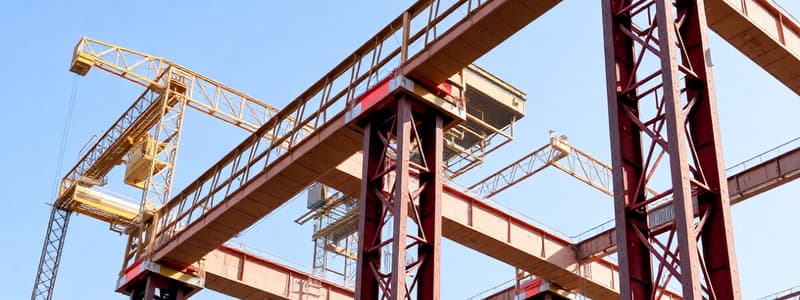Podcast
Questions and Answers
What are the three main load types that structural engineers consider when designing structures?
What are the three main load types that structural engineers consider when designing structures?
Dead Load, Live Load, and Environmental Load.
What distinguishes determinate structures from indeterminate structures in structural analysis?
What distinguishes determinate structures from indeterminate structures in structural analysis?
Determinate structures can be analyzed using equilibrium equations, while indeterminate structures require more complex methods like flexural or moment distribution methods.
Why is safety a critical principle in structural design?
Why is safety a critical principle in structural design?
Safety ensures that structures can carry expected maximum and unforeseen loads without failure.
Name two software tools commonly used in structural engineering for design and analysis.
Name two software tools commonly used in structural engineering for design and analysis.
What role do building codes and standards play in structural engineering?
What role do building codes and standards play in structural engineering?
How does sustainability impact materials selection in structural engineering?
How does sustainability impact materials selection in structural engineering?
What are some common types of structures designed by structural engineers?
What are some common types of structures designed by structural engineers?
What is the primary characteristic of concrete that makes it suitable for structural use?
What is the primary characteristic of concrete that makes it suitable for structural use?
Study Notes
Structural Load Types
- Dead Load: The weight of the structure itself, including permanent fixtures and components.
- Live Load: Variable loads from people, furniture, and temporary objects.
- Environmental Load: Forces from wind, snow, earthquakes, or temperature changes.
Determinate vs. Indeterminate Structures
- Determinate structures: Can be analyzed using basic equilibrium equations. The forces in members can be determined using simple calculations.
- Indeterminate structures: Have more unknowns than equations, requiring more complex methods to analyze the behavior. Redundancy in load paths often provides structural strength.
Safety in Structural Design
- Safety is paramount to prevent collapse, injuries, and property damage.
- Designs must account for uncertainties in load estimations, material properties, and construction practices.
- This involves using safety factors, which are multiples of the expected loads to ensure structures can withstand greater forces.
Software Tools in Structural Engineering
- Computer-aided design (CAD): Assists with 2D and 3D modeling, drafting, and visualization of structures.
- Finite Element Analysis (FEA): Simulates the behavior of complex structures under various loads, allowing engineers to determine stresses, deflections, and buckling.
Building Codes and Standards
- Building codes: Legal requirements set by governments to ensure structures are safe, functional, and accessible.
- Standards: Developed by professional organizations, providing guidelines and specifications for design, materials, and construction practices.
Sustainability in Material Selection
- Structural engineers prioritize environmentally friendly materials with low embodied carbon, promoting resource efficiency and minimizing the environmental footprint of construction.
- Sustainable materials often include recycled content, renewable resources, and materials with reduced energy consumption during production.
Common Types of Structures
- Residential buildings: Single-family houses, apartments, and condominiums
- Commercial buildings: Offices, retail stores, hotels, and hospitals
- Industrial buildings: Factories, warehouses, and manufacturing facilities
- Bridges: Structures that span over waterways, valleys, or roads
- Tunnels: Structures that provide passage beneath ground or water
- Stadiums and arenas: Large venues for sporting events, concerts, and other gatherings
Concrete's Strength
- Concrete's high compressive strength makes it suitable for resisting crushing forces in structural applications.
- Concrete's ability to be molded into various shapes contributes to its versatility in structural construction.
Studying That Suits You
Use AI to generate personalized quizzes and flashcards to suit your learning preferences.
Description
This quiz covers the foundational aspects of Civil Engineering, including its various subfields like structural and transportation engineering. Focus is given to key concepts of structural engineering, such as load types and structural analysis methods. Test your knowledge and understanding of these essential principles.




